All you wanted to know about Japan… And more…
Where being polite is a way of life, cross talking is a strict NO-NO, where people address each other adding a “san” to the name, where speaking loudly in public doesn’t happen, where being late is not an option…
Sounds too good to be true? Well, this happens in Japan…
Intrigued? There is more!
So how many days are good to explore Japan?
The answer is, “it depends”. Sounds clichéd, but true. Once in Japan, you will be overwhelmed by the number of things you want to experience and places you want to explore. You can never feel like you have seen or explored enough. A country with more than 6000 islands, where natural beauty is mesmerising and technology itself is a great attraction. Japan despite huge technological advancement has retained the cultural fabric of the country in its true form and this is what makes Japan a must place to visit
Let’s start with some of the top places to visit in Japan
Tokyo is the financial centre and the capital of Japan – intensely cosmopolitan! A unique place where technology and tradition go hand in hand. Go on a dinner with Robot, stroll through the busy Shibua crossing, watch a Sumo match, visit the world’s first food-themed park or Climb up the Sky tree. Don’t forget to visit the Pokémon centre.
Yokohama – A city with its own international port to the south of Tokyo, this place is known for microbreweries, beautiful gardens and the tea ceremony. It has many firsts to its name -. Japan’s first bakery, brewery, photo studio, cinema, newspaper, public restroom and ice cream, started from Yokohama
Kamakura – This ancient city with its temples and shrines, was once the power house of Japan in the 13th and 14th centuries. It is very peaceful and serene, with 65 Buddhist temples and 19 Shinto shrines spread throughout the town and surrounding wooden hills.
Kyoto

With many ancient Buddhist temples and gardens, Kyoto is the ancient capital and cultural heart of the country. A city dotted with temples and shrine take you on a spiritual journey. Don’t forget to meet the Geishas in Gyon
Hakone: A town at the foot hills of Mt fuji, is also known as the spa destination of Japan. Hakone is scenic and also has a lot of museums for the art lovers. Don’t miss the open-air museum, when in Hakone
Hokkaido/Sapporo: If autumn is about Lavender, then winter would be about the Sapporo snow festival. Sapporo is beautiful throughout the year. Don’t forget to visit the Sapporo beer museum
Hiroshima – Apart from the stories of World War II bombing, Hiroshima is a large city port with much to explore.
Nara – The first capital of United Japan, this is home to many Buddhist temples, shrines, gardens and historical buildings. Nara deer park is a must experience, where thousands of deer roam freely.
Nagasaki is an ancient port city with a unique Dutch and Chinese influence.
Sendai, known as the “City of Forests” for its trees and wooded hills
Shizuoka: Indulge in nature, culture food, tea or just chill by the beach. Picking strawberries, oranges, or plucking tea is also a great experience in Shizuoka
Hamamatsu: it is one the manufacturing hub of Japan and also the town of music. It boasts of the Hamamatsu Museum of Musical Instruments and the Hamamatsu Flower Park. It is also home to Lake Hamana, one of the best lakes of Japan.
The list is long, but for now these would have given you some insight into Japan.
Here are some of the experiences, which will explain Japan better
The experiences in Japan will always surprise you , whether it is the natural beauty, the history and heritage of the country, art forms, tall buildings or the cutting edge technological innovation.
Let’s take a look at few experiences which are a must in Japan . ( in no particular order)
Natural Beauty
Lava Delight : Mt Fuji
Overlooking the cities of Tokyo and Osaka, Mount Fuji stands tall. It is also considered as a sacred placed by the locals
Cinderella’s Escape (Kawachi Fuji Gardens, Kitakyushu)
If you ever wanted to be a part of a fairy tale as a child, it’s not too late now.
Take a walk through the Wisteria Tunnel at the Kawachi Fuji Gardens in Kitakyushu and see your bedtime stories come to life. This flower tunnel turns magical in late April or early May when the Wisteria comes to a full bloom.
Too blue to be true (Bei, Hokkaido)
Tucked away in a forest near Bei lies a blue pond (the blue being really blue) straight out of a magical tale. This place will help shoo away your blues (pun intended).
The Talking Bamboos (Kyoto, Arashiyama forest)
A walk through the Sagano Bamboo forest is a must in Kyoto. The thickly packed towering bamboos create a pleasant music. The place is recognised as a soundscape by the Japanese government.
Paint it Pink (Higashimokoto Shibazakura Park, Ozora)
A grand pink carpet is rolled out for you at the Higashimokoto Shibazakura Park. But you are not supposed to walk on it. It is formed by the blossoming of shibazakura (pink moss). Japanese people celebrate the floral beauty every year in the month of at the Higashimokoto Shibazakura Park.
The Cherry on Top (Cherry Blossom)
Spring fever runs high in Japan. With cherry blossoms gracing the landscape, Japan turns into a magical dream for anyone who visits. Colleagues, friends and family members gather and
sit on plastic mats under the pink trees to sing, drink, chat or simply admire the beauty all around them. April and May are the best months to visit. It is also considered a new beginning
Land of Lavender (Furano, Sapporo)
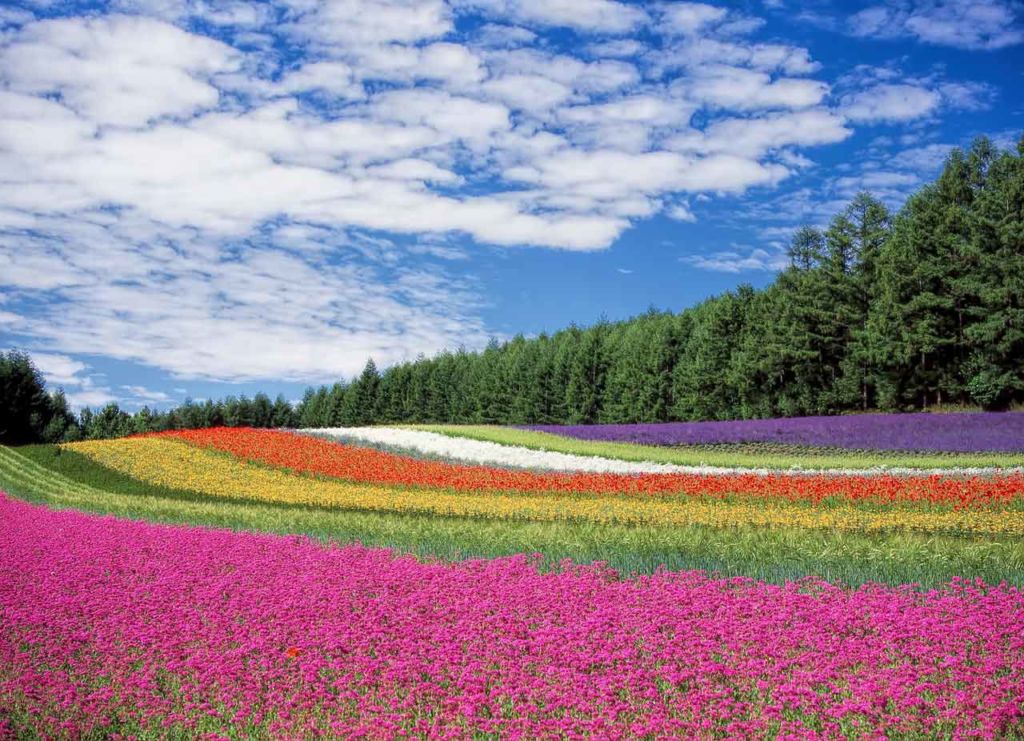
Don’t forget to visit the Tomita farms in July when the Lavender is in full bloom
History & Culture
Walk through thousand vermillion gates (Fushimi Inari Shrine, Kyoto)

Ten thousand vermilion gates greet you with contrasting rich green trees in the background as you enter Fushimi Inari Shrine. The shrine is dedicated to Inari, the Shinto God of rice. The picturesque torii gates lead into the forest of the sacred Mount Inari.
The other interesting thing there are dozens of statues of foxes across the shrine grounds. Foxes or kitsune are regarded as the messengers of the Gods.
A Steamy Experience (Onsens)
If you are in Japan, spending some time at the Onsen (hot springs) is a must. The country is dotted with natural hot springs. Different minerals are dissolved in different hot springs providing distinguished benefits. You can stay in a Ryokan (Japanese style inns) and experience these Onsen true Japanese style
Remembering World War II (Hiroshima Peace Memorial, Hiroshima)
The Peace Memorial Park is a tribute to the victims of the bombing during World War II. A UNESCO World Heritage, gives an insight into the tumultuous past.
Something Fancy (Himeji Castle, Himeji)
Himeji castle transports you to a different era. Its elegant architecture is complemented by the beautiful cherry blossoms which line the outside. The castle is made up of eighty buildings connected by winding paths, making it an interesting walk way.
Heaven for Art Lovers (Pigment, Tokyo)
If rainbows have held your fascination, you haven’t yet been to Pigment.
An art store in Tokyo, it carries every shade of the rainbow, making it a dream destination for every artist. Pigment sells dry coloured dust which can be used to give hue to fabric, plastics and paints alike.
Meeting with Geisha
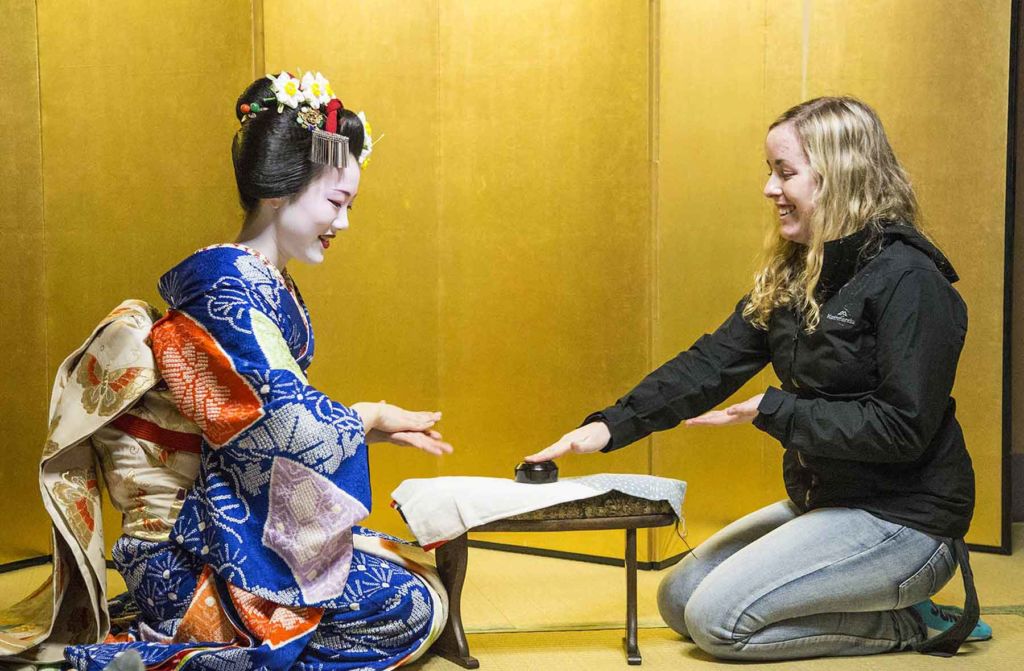
Geisha, are artists who are trained in music, dance, singing etc. You can meet with the Geisha and apprentice Geisha, called Maiko or Geiko, can be seen in Gion, Kyoto. Tea ceremony with a Geisha is a great experience.
The Cha experience (Japanese Tea ceremony)
If chai was only about charcha then you are wrong. In Japan, the tea ceremony which means the preparation and drinking of tea is a highly spiritual process. The tea ceremony is called Cha Noyu or sado and involves Japanese green tea called matcha. The host prepares tea for the guest and the entire process is taken very seriously.
Art & Architecture
Art Island Naoshima
Artiste’s paradise, Naoshima is a must-visit, with museums designed by Tadao Ando and works by world-class artists from around the world. Don’t forget to visit the nearby art islands of Teshima and Inujima
Sky Tree Tokyo
It is the tallest building in Tokyo, and its design was inspired by the Japanese Pagodas
Todaji Temple Nara
Todaji Temple, used to have two Pagodas, that were just a littler shorter than the Pyramids. They were destroyed in an earthquake. The temple still has large buildings and the statue of wooden Buddha.
Yokohama Land mark Tower:
It is the 2nd tallest building in Japan. Its elevators are travel at the speed of 45kms per hour and the journey to the top floor (69th) takes 40 seconds
Himeji Castle
Located on top of a hill called Himeyama, this largest surviving castle of Japan has 83 buildings and two moats. It is often referred to as Hakuro-jo (white castle) because of its white coloured exterior
Now on to Some Beyond the usual experiences!
Now that we have taken a short virtual tour of Japan through the places and experiences , it’s time to not trip on the usual and explore some of the unusual stuff in Japan.
Monster Street (Yokai street Kyoto)
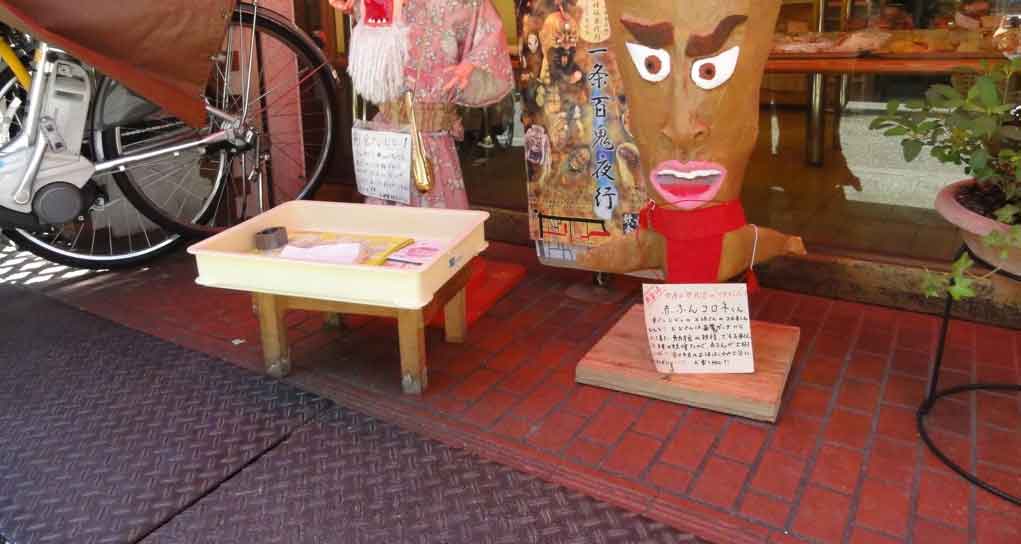
A street filled with a dozen homemade monsters? Why not?
Monsters (cute ones) will greet you at the shops at Yokai Street of Kyoto. Yokai is Japanese for monster and is a part of many Japanese legends. They can be humans, animals or simply inanimate objects like a broom for example. The street lined with Yokais is also an attempt to keep the forgotten Japanese folklore alive.
Cats can get you lucky
Hundreds of Maneki-neko (cats) dot the Gotokuji Buddhist temple in Tokyo. These cats are born and brought up at the temple complex and are considered a good luck charm according to a legend. All of them have one paw raised as the legendary cat beckoned an Edo period feudal lord to safety during a thunderstorm
Spa for the Monkeys (Jigokudani Monkey Park, Yamanouchi)
If you ever wished to see monkeys enjoying a hot spring spa (quite an unusual fantasy), Jigokudani Monkey Park will certainly not let you down. This snowy cold land of Yamanouchi is popular for the Japanese Macaques or the Snow Monkeys which inhabit it. These are also the most northern living non-human primates which warm themselves comfortably in the steamy retreat.
A Rocky Marriage (Meoto Iwa, Futami)
Located just off the shore of Futami are two rocks which are married together. Yes, you read it right. These “lover’s rocks” and “wedded rocks” called Meoto Iwa together are connected at all time by a thick rope. In the Shinto faith, they represent a holy union. For the diehard romantic, this is a must visit
Key to Heaven’s Door (Zenkoji Temple, Nagano)
At Zenkoji Temple, you have the chance to touch the key to heaven. Locals believe that touching the key results in happiness after death. The key lies in a tunnel beneath the main temple. However, the path to the key is a dark tunnel. As they say there is happiness and light at the end of the tunnel.
For the love of cats (Okishima Cat Island)
Okishama is one of the cat islands of Japan where the furry creatures roam free. Apart from the cats, the town has an intriguing history filled with samurais who sought refuge in the island centuries ago.
One call away (Wind Phone, Otsuchi)
What if you could make a call to your lost loved ones?
Kaze no denwa or “wind phone” was built by Itaru Sasaki to cope with the death of his cousin. He used to dial his cousin’s phone number on an old, unconnected rotary phone, and his words would be “carried on the wind” as he spoke. A year later in 2011 when Tsunami hit Japan this phone booth was opened up for the public to deal with grief
Rice Animals (Niigata)
What do you do with rice? Eating it is old school. Try giant animal sculptures.
After the rice is extracted from the crop a huge amount of rice straws called Wara is left over. In Niigata it’s put to an even more creative use and transformed into giant, fantastic animal sculptures. These golden artworks, made by piecing patches of braided straw over a wooden frame, can be seen on display at the annual Wara Art Festival in Uwasekigata Park.
Disney Sea for All (Disney Sea, Tokyo)
Visiting Disney Land has been a part of everyone’s bucket list at some point. You can tick that off (almost) at the Disney Sea which is the world’s only sea themed Disney Park.
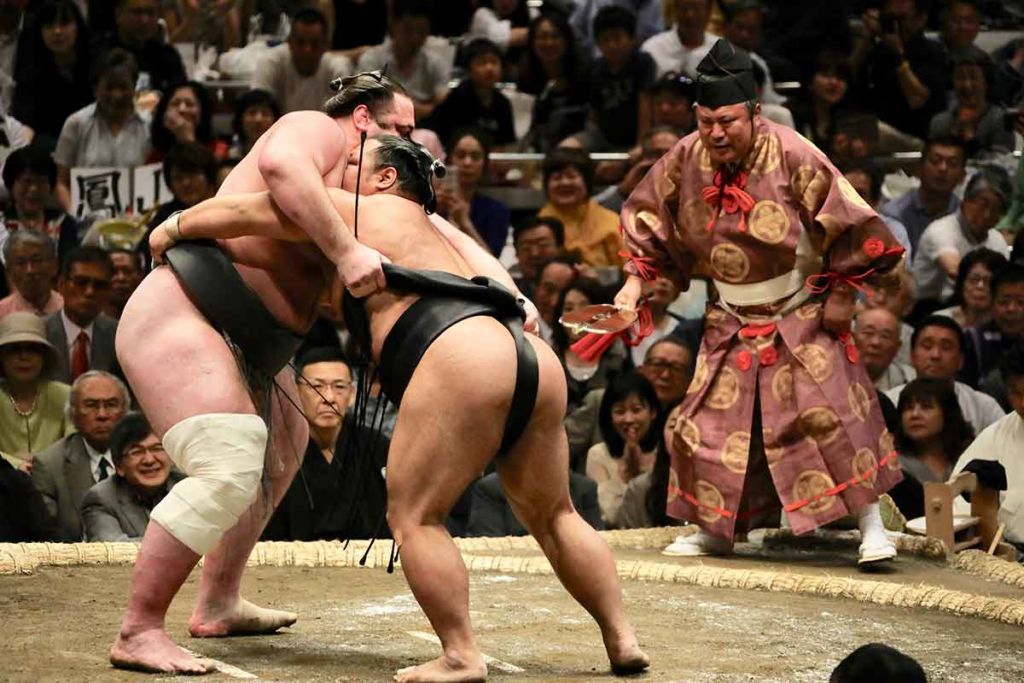
Sumo wrestling is an age old traditional Japanese sport which continues to draw hundreds of spectators even today. It is followed like a religion by many fans. Don’t forget to watch a live Sumo wrestling match. Every odd-numbered month of the year, there is a Sumo Grand Tournament somewhere in Japan. In case you miss the matches, you can observe the sumo practises and trainings.
A number of Sumo training houses are located in Ryogoku area, Tokyo where wrestlers live and practice.
Remember the Samurai movies? You can visit Kanazawa which has the Samurai district of Higashi Chaya. It also has the Kanazawa castle which is one the best-preserved Samurai castles. You can also plan a visit to the Samurai museum in Tokyo which is dedicated to keeping the rich samurai history alive.
Technology you can’t miss
We have spoken a lot about Japanese culture, natural beauty, art forms. Japan is also a country known for technological edge. Travel to Japan is incomplete without experiencing a slice of technology and innovation. Here is a small list of must experience
Ride like a bullet and get served by a Robot
Ride a bullet train running at a speed of 350 km/hr whizzing past the city landscape. Distance is just a number when you are in Japan
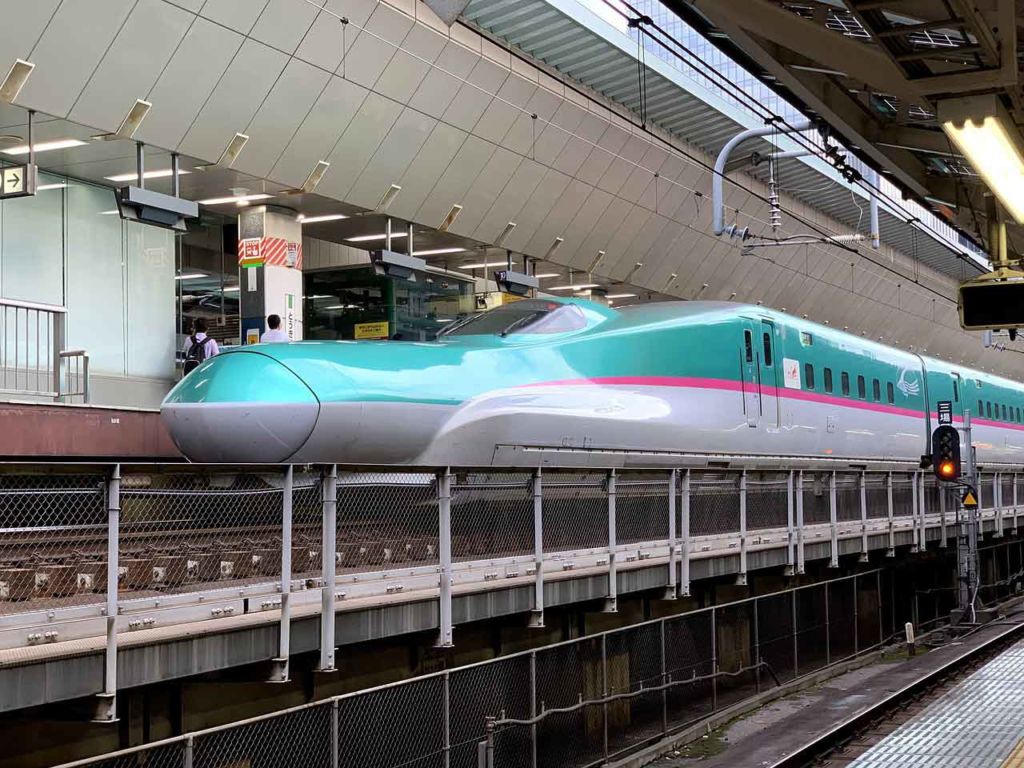
Eat in a restaurant where robots take your order. As you walk out of a restaurant you see a huge robot moving its arms and you realise that you truly are in a highly tech country which seems to live in the future.
And if you want to feel very important, head to the Kabuki Cho restaurant in Tokyo. One lady takes your order, other gives a dance performance while other laughs at your jokes. What seems like the ultimate fantasy for most men, comes to life in the Kabuki Cho Restaurant, Tokyo except all the earlier mentioned women are robots.
These robots are based on video games characters and have the ability to show a variety of emotions.
Anime Lovers Unite (Gundam, Tokyo Bay)
A 20-foot robot overlooks the Tokyo Bay, is a life-size, plastic replica of a robot from Gundam, (a hugely popular Japanese animation series). The robot can move its arms and head and plays disco music and is a hotspot for anime lovers.
Lost in Technology (Akhibara)
A visit to Akihabara district in Japan is every tech lover’s dream come true. Hundreds of electronic stores line the streets of the district. From newest inventions to electronic junk, the stores offer everything. It is also the centre of Japanese Otaku and anime culture with stores selling retro video games and figurines.
Fast and Furious (Japan Metro)
One thing you definitely can’t miss while in Japan is the metro. It is an experience of another kind especially if you are used to travelling in the snail-paced Indian trains.
A 20 inch you (Clone Factory, Akhibara)
Japan is always a step ahead when it comes to human cloning. At the Clone Factory in Akihabara, you can get a 20-inch doll with your head. They take a 3D model of your head, print it out on a 3D printer and once it is ready you can choose the body and outfit for your mini head.
This was a Beyonder’s insight into Japan, and we hope it has created some curiosity in your mind. Now some food for thought !
An quick peek into Japanese food and beverages
If I were trapped in one city and had to eat one nation’s cuisine for the rest of my life, I would not mind eating Japanese
JAPANESE CUISINE
Did you know that Japanese cuisine, also known as “Washok”, is a part of the UNESCO Intangible Cultural Heritage List? Japanese food because of its freshness, simplicity and colourful-ness, becomes both a visual and gastronomical delight. Tokyo is home to more than 302 Michelin star Chefs. Complementing the food is the variety of dining experiences – robot-filled restaurants to meditative tea rooms. And to top it all, Japanese food is also relatively light on the pocket.
Top food experiences not to be missed in Japan
RAMEN
Nissin, the father of noodles is from Japan and this Japanese speciality is a must. Soon, a simple bowl of Ramen might become your most sought-after comfort food. In some restaurants you’ll even find a vending machine, which you use to buy your Ramen.
SUSHI
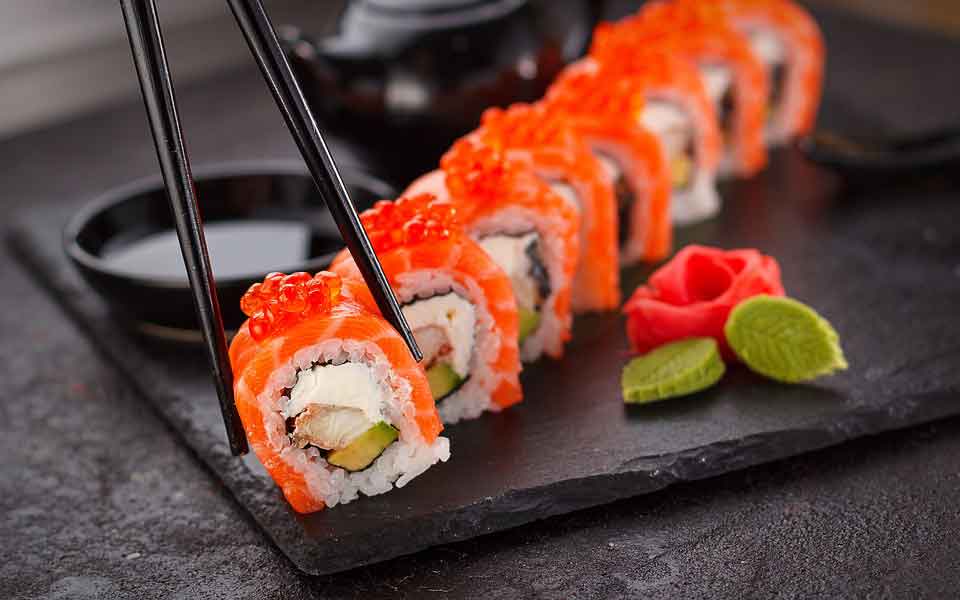
Sushi is synonymous to Japan like pizza is to Italy. You will get this delicacy in almost every restaurant you visit and in a variety of flavours too. It is quite wrongly assumed that Sushi is just rolled rice and sea food. It, in fact, refers to foods that use a type of rice seasoned with vinegar. And Sushi is not everyone’s cup of tea. To become a traditional Sushi chef, you need to undergo many years of apprenticeship with a Sushi Master.
SASHIMI
This dish is like a sister to Sushi and more often than not confused with it. This is an appetiser and is usually served with soy sauce. Japanese chefs consider Sashimi the finest dish in Japanese formal dining and quite rightly so. It is not always a fish-based preparation, meat is also a commonly used base for Sashimi.
TEMPURA
The Portuguese brought this dish to in Japan in the 16th century japan and now it is an integral part of the cuisine. It is basically battered and deep-fried vegetables or seafood. This crispy treat is served hot with salt or a dipping sauce.
OKONOMIYAKI
If you love pancakes, then you must try the Japanese version of the dish. From vegetables and pork belly to octopus and squid you will find numerous variations to it. In some restaurants you can even cook your own, but going with the Chef’s preparation will be a good choice.
JAPANESE SWEETS (WAGASHI)
 You might not feel like biting it into pieces, after all they are so colourful. Like we said earlier, treat to the eyes and taste buds alike! Also known as Wagashi, they are prepared using plant-based ingredients and make for a good tea accompaniment.
You might not feel like biting it into pieces, after all they are so colourful. Like we said earlier, treat to the eyes and taste buds alike! Also known as Wagashi, they are prepared using plant-based ingredients and make for a good tea accompaniment.
UDON
It’s a variation of the noodles, thicker and more chewy. It is usually served hot as noodle soup but can be served cold too. So find your variation and dig in!
MISO SOUP
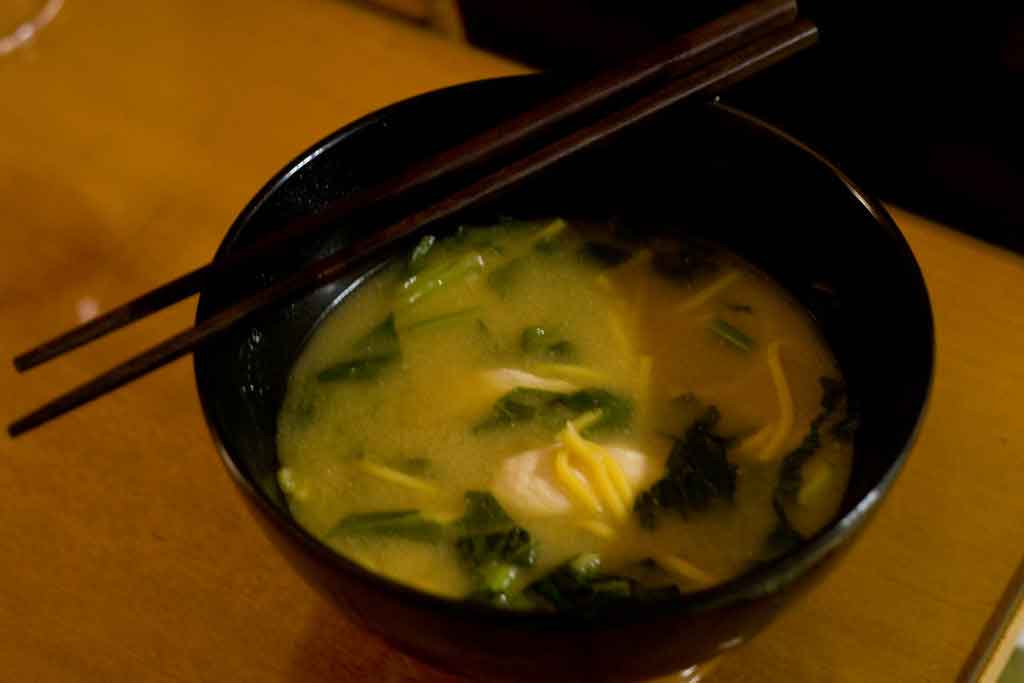
It is an integral part of the Japanese dinner and is served as the first item. Miso soup prepared with soluble fermented soybean paste and other ingredients like seaweed, tofu etc.
Vegatarian Food in Japan
Are you a vegetarian and worried about what to eat in Japan? We have you covered J. Japan offers a variety of vegetarian and vegan dishes. From Veg Sushi to Veg Ramen, it’s all there!
Here are a few that we have listed for you…
ZARU SOBA
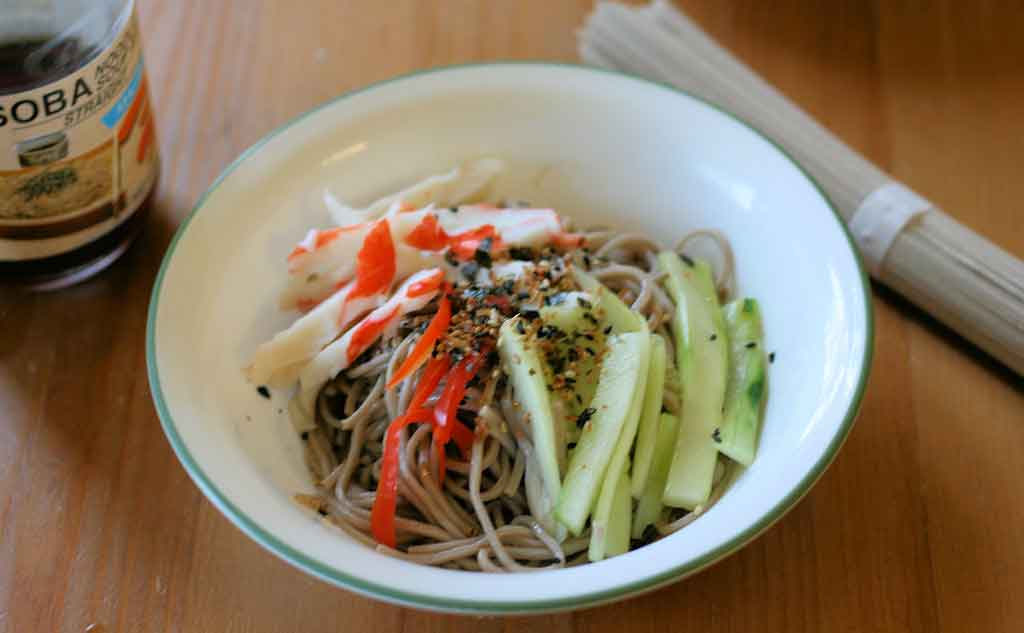
A bowl of Zaru Soba is the refreshment you need in the summer heat. This is a chilled noodle dish made from buckwheat flour. Often served on a bamboo tray, this is a must if you want to beat the heat in Japan.
JAPANESE CURRY

If you miss a bit of India while in Japan, try the Japanese curry. This is made with a variety of vegetables and can be enjoyed with rice, bread and udon alike. This popular dish is prepared with a mix of spices that add to the taste.
NASU DENGAKU
Who said eggplants couldn’t be mouth-wateringly delicious? Have a bite of Nasu Dengaku and you will change your view. This grilled eggplant, caramelised with miso sauce is a comfort food for many.
RAMEN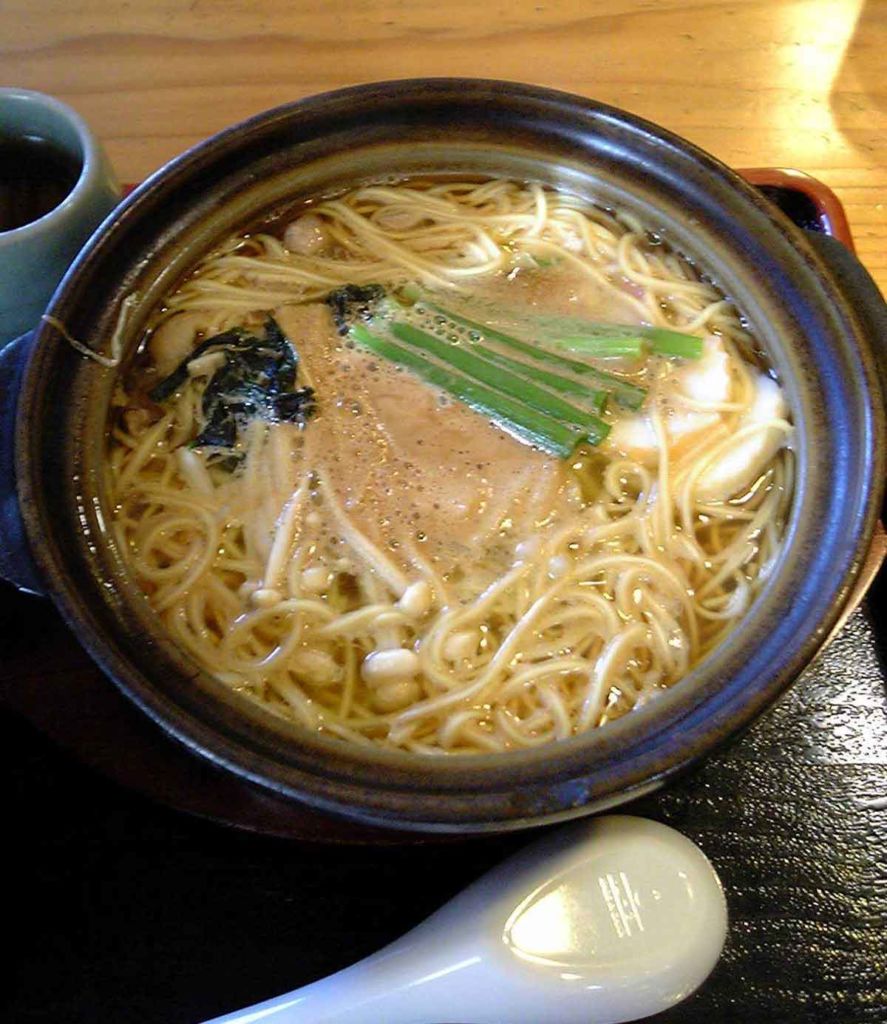
Do not worry about missing this classic Japanese dish for many stores offer vegetarian Ramen these days. The Ramen bowls offer a variety of colourful vegetables making it irresistible.
SUSHI
If you thought Sushi is all about fish, then you are up for a surprise. Most of the Japanese restaurants now offer vegetarian Sushi in their menu. Do try kappa-maki (seaweed rolls with cucumber) and takuan-maki (pickled daikon radish roll) in Japan.
DRINKS
Kanapai! The most commonly used word in Japan which means “Cheers”. Drinking in Japan is usually with a meal or a snack. The Japanese know well the art of balancing their drinks. From the rice wine to world famous green tea, they have it all.
SAKE
You cannot leave japan without having a glass of Sake (rice wine). This alcoholic drink is the national beverage of Japan. It’s customary to pour Sake for others (with two hands on the bottle) and not for yourself. In fact this is the tradition for any drinks – allow someone to pour your Sake.
CHA
Tea is called Cha in Japan and Japan loves its tea! The range of tea varies from green tea to barley tea, to buck wheat tea, brown rice tea and more. For tea lovers, there are endless options. Sado (Japanese green tea ceremony), literally means “the way of tea”. It is centuries old tradition rooted in Buddhism which involves the preparation and drinking of tea. Sado is taught in schools across Japan.
MATCHA

This drink has been creating quite a buzz lately. Matcha refers to powdered green tea which is then infused in hot water. It is known for the numerous health benefits it possesses. But even more than that, the whole act of drinking it is quite spiritual and meditative.
SHOCHU
Shochu is the most popular Japanese drink you’ve never heard of. It’s a staple Japanese alcohol and provides a base to other drinks as well. This drink has a unique earthy flavour which will keep you slowly sipping onto it.
WHISKEY
After being hailed as the world’s best whiskey in 2014, Japan’s whiskey industry has been on a boom. Whiskey has always been a classic for the country. For a truly high-class experience, treat yourself to a glass of Yamazaki Single Malt Sherry Cask, the winner in 2014’s World Whiskey awards.
We are sure, that was some Food for thought in Japan and now you are tempted to say “Kanpai”…
There is more to Japan, than what we have summarised. Keep watching this space for more from Japan


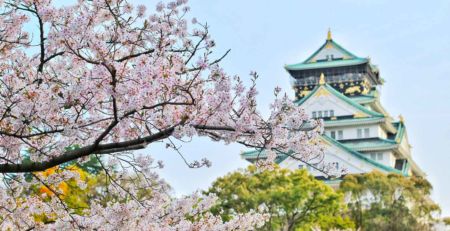
Leave a Reply